![]()
Joann Cadavis Cachola
Lucy Peros | All photos courtesy Joann Cachola ‘Ohana
“Love knows no age, when you find true love, you will not care about the age difference, all you will care about is spending forever with him/her.” This is what an unknown thinker once said. This proved to be true about the Sakada parents of this month’s featured Sakada Offspring, Joann Cadavis Cachola.
Joann was born on Maui on April 28, 1972. She attended Kahului Elementary School, Maui High School (Class of 1990) and Maui Community College. She received her Bachelors Degree in Human Services from Hawai‘i Pacific University in Honolulu. She is presently working at Maui Memorial Medical Center in the Utilization Review and Case Management Department.
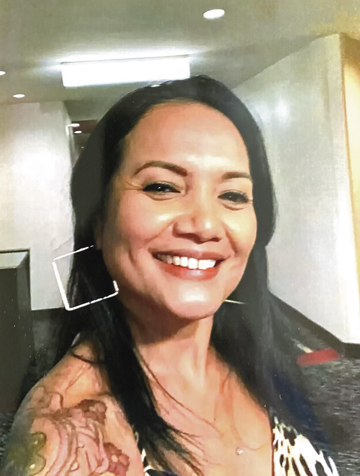
Joann’s daughter Sierra Perryman (19 years old) attends the University of Hawai‘i Maui College and hopes to be a Clinical Psychologist someday. Sierra was Miss Barrio Fiesta in 2018.
Joann is a community oriented individual. She participated in the Relay For Life and helped at the Christ The King Church Bazaar. She was in the Christ The King Junior Filipino Catholic Club Choir and participated in the Christ The King Flores de Mayo. She is a very physically fit individual. She dances Tahitian, participated in Retail Therapy, Zumba, Yoga and Jui-jitsu.
Besides Joann, there are other siblings in the Cachola Family. Next to Joann is Karren Cachola Caldito. She works at Maui Memorial Medical Center as a Health Unit Clerk. She is married to Chad Caldito. Chad works at the Maui County Parks and Recreation Department. They have a daughter together, Leihiwa Caldito (eighth grade) at Maui Waena Intermediate. They have other children from previous relationships. First is Jared “Riannon” Cachola Kekino. He works for Inspiration Events. Second is Jordan Cachola Kekino. He works for building maintenance with American Property Management in Arizona.

The youngest of the Cachola siblings is Randell “Leimomi” Cachola. He is a painter at Painters Union/Sons. He has three children: Ranson (7), attending 1st Kīhei Charter School, Leighsyn (4), a preschooler at Grace Bible Pre-School and Kyler (21 months).
Joann, Karren and Randell are the daughters and son of the late Sakada, Catalino Cacho Cachola and Veronica Cadavis Cachola. Catalino was born in Dasay, Narvacan, Ilocos Sur, Philippines on March 22, 1913. Life in the Philippines was very hard. Catalino and his family were farmers and farmers are always under the mercy of God and nature to raise successful yearly crops. A devastating monsoon weather can wipe out crops in no time. So men like Catalino opted to come to a strange land called Hawai‘i to find a better life for themselves and for their families.
Together with his friends, Francisco Cabrera and Mateo Pascua, they left the Philippines from Port Salomague, Cabugao, Ilocos Sur in 1931.
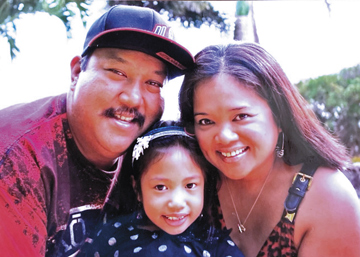
Arriving in the Territory of Hawai‘i in 1931, Catalino was assigned directly to the Hāmākua Mill Company on Hawai‘i island. After three years, he transferred to the Kaiwiki Sugar Company also on Hawai‘i island. He worked there for five years. It was quite a rainy place there. Catalino often mentioned to his wife it was better to forget his lunch cans than to forget his raincoat.
In 1940, he decided to transfer to the Hawaiian Commercial and Sugar Company in Pu‘unēnē, Maui. He lived at Camp 2 in Spreckelsville. He was a cane cutter, a mule man, and then as a helper to the cane harvesting machine. In 1946, Catalino became a cultivation contractor. He retired from HC&S in 1975 from his job as a weed controller.
Catalino served with the Maui Volunteers as a private, Company K, 3rd Battalion, 1st Regiment, Spreckelsville, Maui. He was awarded the Volunteer Service Ribbon on July 4, 1945. The Maui Volunteers was the forerunner of the Hawaii National Guard.

In 1970, Catalino decided to go back to the Philippines to get married. At his hometown in Dasay, Narvacan, he saw a very attractive, very industrious young lady by the name of Veronica Cadavis. As a young woman, Veronica was very good in weaving using a wooden loom to weave beautiful blankets and cloths for dresses. She grew up in Santa, Ilocos Sur, Philippines. Santa is famous for their beautiful handcrafted woven blankets and good, handcrafted machetes (buneng).
Because Veronica and Catalino did not know each other beforehand, it was the elders from both of their families that planned their marriage (nagdadanon). Though with much hesitancy, because of their age difference, Veronica went along with the wedding plans anyway. Catalino was already 57 years old while Veronica was in her twenties.
Catalino’s vacation was coming to an end so quickly. He had to come back to Hawai‘i to his work. So to expedite matters, Catalino and Veronica decided to go to Manila to get married. They had to go to two different churches to bless their marriage. The first one did not accept to marry them because when the priest interviewed Veronica and asked her if she really loved Catalino, her answer was, “I am marrying him because I am just following my elders’ recommendation.” Because of that answer, the blessing was not granted. Veronica was too honest! Then they went to another church. The priest there did not ask too many questions. So he married them right away. They were married on December 2, 1970. In just two short days later, on December 4, 1970, Catalino had to come back to Hawai‘i. In June 1971, Veronica followed Catalino to Hawai‘i. They lived in the 10th increment in Kahului. Veronica still lives there today.
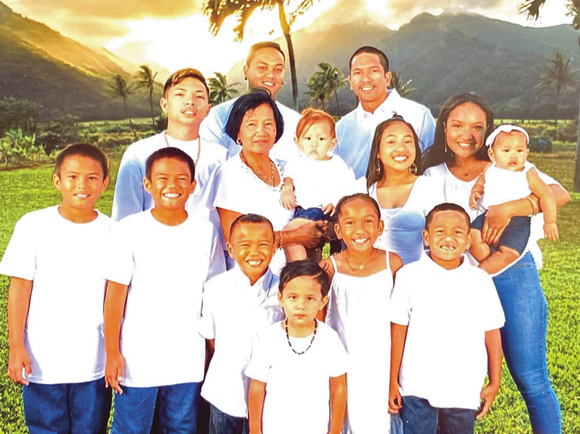
Catalino enjoyed playing Sakura (Hanafuda), gardening and cooking. In fact, he was often asked to be the head chef at parties at the old Pu‘unēnē Filipino Clubhouse. His favorite dishes to cook were igado, adobo and the meaty bone pork tempura. Unfortunately, Catalino passed away in November 1999.
When Veronica arrived in Hawai‘i in 1971, she worked at the Maui Pineapple Cannery as a trimmer. She stayed home from 1972 to 1973 when her two daughters, Joann and Karren were young. In 1974, she went back to work, this time at HC&S. She did jobs such as cover seed, replant, cut seed, weed control and irrigation. In the meantime, she is so industrious she even went to work at the hotel and at Howard Nursery as her part-time jobs. She retired in 2006.
Veronica lovingly shared her personal feeling about her husband, Catalino. She said, “I learned to love my husband even though he was way older than I was. People even asked me if he was my father and the grandfather of our children. I didn’t mind them. I just told them the truth that I wanted to come to Hawai‘i and find a better life for me and my family. He was a good and loving husband to me and a good father to our children.” That love grew and nurtured between Catalino and Veronica. In time, they were blessed with three now grown-up children and grandchildren, successful in their fields of interest. Veronica is a very active member of Christ The King Church in Kahului as Eucharistic Minister, choir, prayer group whose goal is evangelization, serves the homebound, MBCC (Missionary Basic Christian Community) Renew, Church cleaning and bread making ministries. Veronica is a very loving mother, grandmother and great grandmother. She babysat all her grandchildren and now great grandchildren.
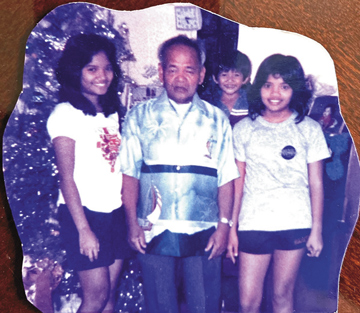
Joann, Karren and Randell shared these very heartwarming and humorous reflections on their Dad, Catalino Cacho Cachola.
Randell reminisces about his Dad. “When I was young, I remember going for a ride in my Dad’s brown Chevy Nova. We would go to the old Kahului Shopping Center and get boiled peanuts from Noda Market, eat them while we hang out with the OG’s (Older Guys). After that we would head across the street to the Maui Mall to get some Guri-Guri. My Dad was loving, caring and had a sense of humor. Every time someone would come over to our house to get massaged, he had no doubt in his mind that when they left him, they were healed. I’m proud that although my father passed away while I was at a young age, I have these great memories to hold onto and his legacy to pass on to my sons. It brings me great joy to know that my father, Catalino Cachola was one of the first Sakadas to come to Hawai‘i to work in the plantation. His hard work and dedication paved the way for me to raise my family. I’m blessed to be able to carry on the Cachola legacy.”
Karren Cachola Caldito shares her memories of her Dad. “I remember growing up, people with injuries would come to my dad to get ilot (massage) and he would massage them with some vinegar and they would leave feeling much better. He showed us how to take out the seeds from the achiote pods and told us to rub it on our lips to use as lipstick. He would wake up early every day, boil his eggs and have coffee for breakfast. Then he put on ‘Body by Janis’ exercise and his Budweiser would be on the table ready for an after-exercise drink.”
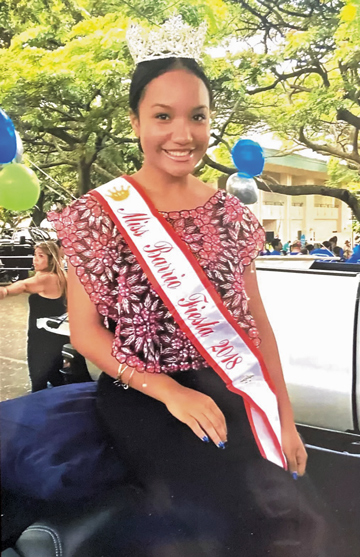
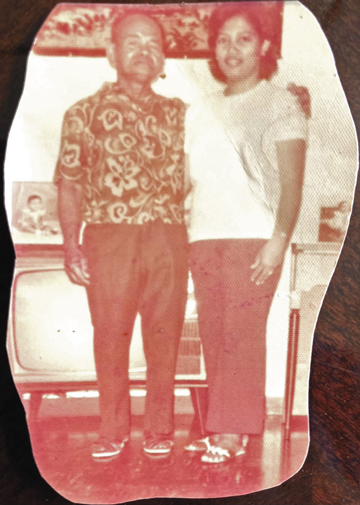
Joann, the oldest of the Cachola siblings, discusses her Dad’s legacy. “My Dad lived a simple life. He never forgot where he came from. He left his family and came to Hawai‘i on a boat with his youngest brother, Roman. Uncle Roman lived a couple of streets over. So, we would go over often to play with the cousins. My Dad was a humble man. He lived his life to the fullest with Budweiser beer and a shot of gin or whiskey. What I cherish the most is learning life skills from him, learning to eat what was grown in the backyard, how to prepare and cook livestock using everything from it. I love my Filipino food, especially the authentic dishes that I’m sure not too many are familiar with. If you were to put a pig, chicken, rabbit or fish in front of me, I would have the confidence to know how to slaughter it, remove its hair, feather, fur or scales, cut it open, remove the insides and put it on the side to cook later. We Filipinos don’t waste and cook everything. After slaughtering fresh livestock, it’s the best time to cook fresh soup. With fresh pig, my Dad used to cook what we called warekwarek. Cut pork and fat, liver and intestines. What gives its flavor is the bile. This is the bitter juice extracted by the liver and stored in the gallbladder to aid digestion. A favorite authentic dish of mine is the pinapaitan which comes from either cow or goat. Again you use the bile to give it a wonderful flavor, adding tripe, intestines and any other innards you want. My Dad also taught us to eat kilawen, anything raw with his special sauce suka and sili—Hawaiian chili pepper. I always look forward to eating kilawen, especially fresh cut beef and liver soaking in suka (vinegar). Another dish was sapsapuriket, fresh chicken cooked with its blood, gizzards, liver and clusters of young eggs. It’s the same flavor as chicken papaya with added goodness to it. We also ate kuraikai—chicken feet. Some people ask what do you get from eating it? For me, it’s just fun eating the skin, tendons and all its gelatinous parts. We also ate fruits and vegetables grown in the backyard. Fruits like guabana, atis, pias and vegetables like tarong (eggplant), marunggay and kamote (sweet potato). My daughter and her cousins have grown to love eating these authentic dishes as well. Also, back in those days, there were no catering businesses. So, early on a Saturday morning, my Dad and my uncles would gather at our house to prepare to kill a pig and cook the famous foods you would now find at Filipino restaurants. Those foods included dinardaraan, pork and peas, igado and tempura pork bone. And let’s not forget the pancit. It was an all-day event. Then the food would be delivered to the old Pu‘unēnē Clubhouse for the party. Although my Dad left his country at a young age, what he learned from his ancestors has been passed onto the next generation. That’s us. He made sacrifices so he could live a better life and for his family. With that, I have learned to never forget where you came from and to embrace your culture. For that, I hold dear to my heart.”
 Lucy Peros is a retired schoolteacher, having taught at St. Anthony Grade School and Waihe‘e Elementary School. Both of her late parents, Elpidio Cachero Cabalo (a 1946 Sakada) and Alejandra Cabudoy Cabalo of Hāli‘imaile, worked for Maui Land and Pine Company. Lucy now enjoys retirement and has time to join other seniors in the Enhance Fitness Program under the Department of Aging three times a week. She also attends the line dancing class and other activities at Kaunoa Senior Center and joins other Waihe‘e School retirees when help is needed at the school. Lucy also devotes some of her time to activities at Christ The King Catholic Church. She enjoys writing and reading in her spare time.
Lucy Peros is a retired schoolteacher, having taught at St. Anthony Grade School and Waihe‘e Elementary School. Both of her late parents, Elpidio Cachero Cabalo (a 1946 Sakada) and Alejandra Cabudoy Cabalo of Hāli‘imaile, worked for Maui Land and Pine Company. Lucy now enjoys retirement and has time to join other seniors in the Enhance Fitness Program under the Department of Aging three times a week. She also attends the line dancing class and other activities at Kaunoa Senior Center and joins other Waihe‘e School retirees when help is needed at the school. Lucy also devotes some of her time to activities at Christ The King Catholic Church. She enjoys writing and reading in her spare time.
